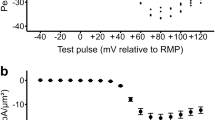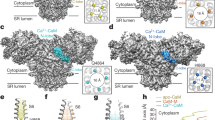Abstract
In many non-muscle cells1,2, D-inositol 1,4,5-trisphosphate (InsP3) has been shown to release Ca2+ from intracellular stores, presumably from the endoplasmic reticulum. It is thought to be a ubiquitous second messenger that is produced in, and released from, the plasma membrane in response to extracellular receptor stimulation. By analogy, InsP3 in muscle cells has been postulated to open calcium channels in the sarcoplasmic reticulum (SR) membrane, which is the intracellular Ca2+ store that releases Ca2+ during muscle contraction3,4. We report here that InsP3 may have a second site of action. We show that InsP3 opens dihydropyridine-sensitive Ca2+ channels in a vesicular preparation of rabbit skeletal muscle transverse tubules5–10. InsP3-activated channels and channels activated by a dihydropyridine agonist in the same preparation have similar slope conductance and extrapolated reversal potential and are blocked by a dihydropyridine antagonist. This suggests that in skeletal muscle, InsP3 can modulate Ca2+ channels of transverse tubules from plasma membrane, in contrast to the previous suggestion that the functional locus of InsP3 is exclusively in the sarcoplasmic reticulum membrane.
This is a preview of subscription content, access via your institution
Access options
Subscribe to this journal
Receive 51 print issues and online access
$199.00 per year
only $3.90 per issue
Buy this article
- Purchase on Springer Link
- Instant access to full article PDF
Prices may be subject to local taxes which are calculated during checkout
Similar content being viewed by others
References
Berridge, M. J. exp. Biol. 124, 323–335 (1986).
Berridge, M. A. Rev. Biochem. 56, 159–193 (1987).
Vergara, J., Tsien, R. Y. & Delay, M. Proc. natn. Acad. Sci. U.S.A. 82, 6352–6356 (1985).
Volpe, P., Salvati, G., Di Virgilio, F. & Pozzan, T. Nature 316, 347–349 (1985).
Affolter, H. & Coronado, R. Biophys. J. 48, 341–347 (1985).
Coronado, R. & Affolter, H. J. gen. Physiol. 87, 933–953 (1986).
Coronado, R. & Smith, J. S. Biophys. J. 51, 497–502 (1987).
Ma, J. & Coronado, R. Biophys. J. 53, 387–395 (1988).
Valdivia, H. & Coronado, R. Biophys. J. 53, 555a (1988).
Vilven, J. et al. Biophys. J. 53, 665a (1988).
Lea, T. J., Griffiths, P. J., Treagear, R. T. & Ashley, C. C. FEBS Lett. 207, 153–161 (1986).
Nosek, T., Williams, M., Zeigler, S. & Godt, R. Am. J. Physiol. 19, C807–C811 (1986).
Walker, J. W., Somlyo, A. V., Goldman, Y. E., Somlyo, A. P. & Trentham, D. R. Nature 327, 249–252 (1987).
Rojas, E., Nassar-Gentina, V., Luxoro, M., Pollord, M. E. & Carrasco, M. A. Can. J. Physiol. Pharmac. 65, 672–680 (1987).
Mikos, G. J. & Snow, T. R. FEBS Lett. 927, 256–260 (1987).
Donaldson, S. K., Goldberg, N. D., Walseth, T. F. & Huettman, D. A. Proc. natn. Acad. Sci. U.S.A. 85, 5749–5753 (1988).
Hannon, J. D., Lee, N. K. M. & Blinks, J. R. Biophys. J. 53, 607a (1988).
Suarez-Isla, B. A. et al. Biophys. J. 54, 737–740 (1988).
Flockerzi, V. et al. Nature 323, 66–68 (1986).
Smith, J. S. et al. Biochem. 26, 7182–7188 (1987).
Rios, E. & Brum, G. Nature 325, 717–720 (1987).
Author information
Authors and Affiliations
Rights and permissions
About this article
Cite this article
Vilven, J., Coronado, R. Opening of dihydropyridine calcium channels in skeletal muscle membranes by inositol trisphosphate. Nature 336, 587–589 (1988). https://doi.org/10.1038/336587a0
Received:
Accepted:
Issue Date:
DOI: https://doi.org/10.1038/336587a0
This article is cited by
-
Investigation of the effect of inositol trisphosphate in skinned skeletal muscle fibres with functional excitation-contraction coupling
Journal of Muscle Research and Cell Motility (1998)
-
Inositol 1,4,5-trisphosphate-induced Ca2+ release is regulated by cytosolic Ca2+ in intact skeletal muscle
Pflügers Archiv - European Journal of Physiology (1996)
-
Inositol 1,4,5-trisphosphate receptor in skeletal muscle: differential expression in myofibres
Journal of Muscle Research and Cell Motility (1995)
-
Inositol trisphosphate (InsP3) causes contraction in skeletal muscle only under artificial conditions: Evidence that Ca2+ release can result from depolarization of T-tubules
Journal of Muscle Research and Cell Motility (1992)
-
Variety of Ca2+-permeable channels in human carcinoma A431 cells
The Journal of Membrane Biology (1991)
Comments
By submitting a comment you agree to abide by our Terms and Community Guidelines. If you find something abusive or that does not comply with our terms or guidelines please flag it as inappropriate.



